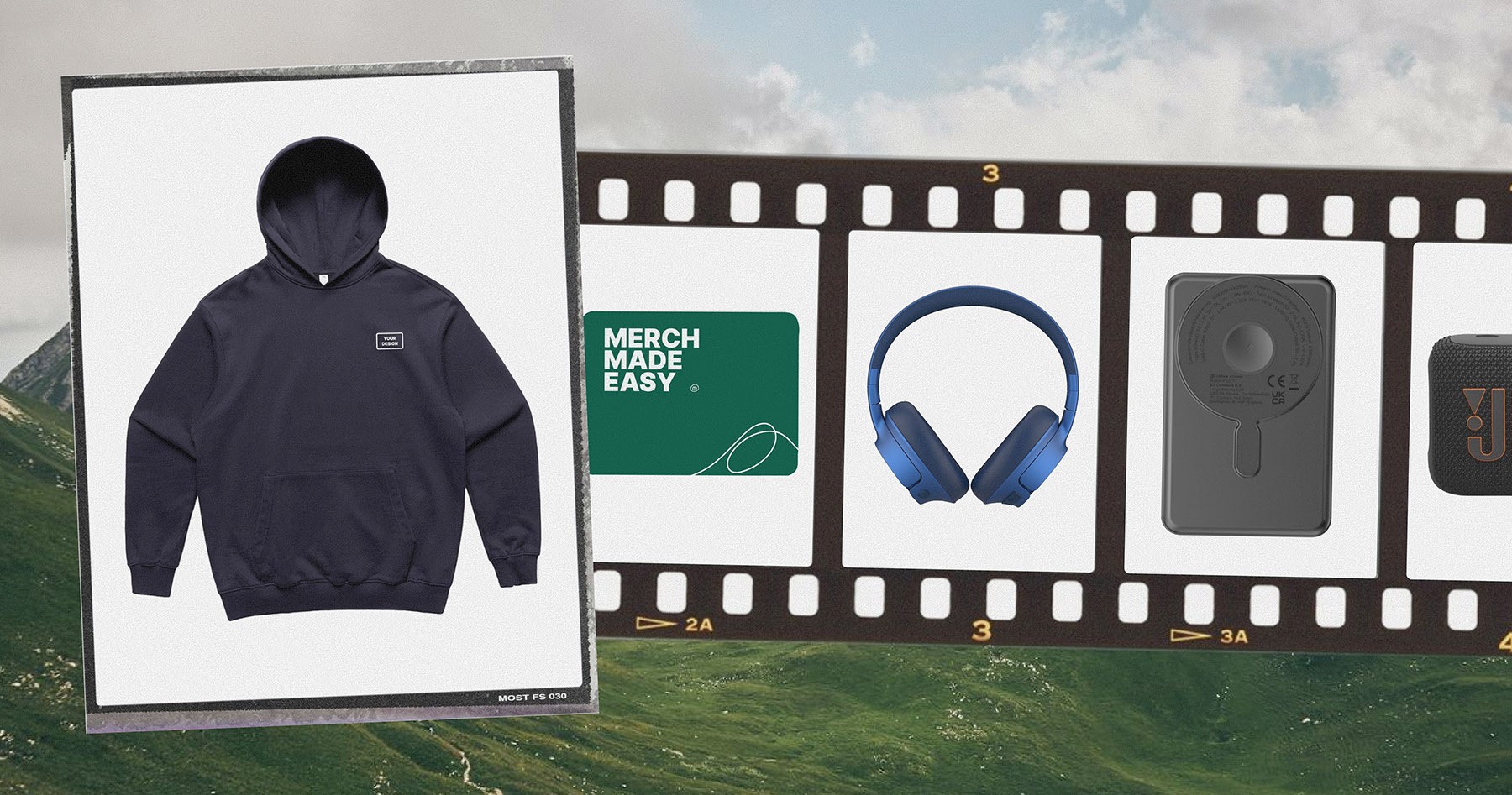How to Use Merchandise to Promote Your Company Brand and Identity
How to Use Merchandise to Promote Your Company Brand and Identity
How to Use Merchandise to Promote Your Company Brand and Identity
Dec 15, 2022
3
Min Read



It's important for companies to have a strong brand and identity that sets them apart from the competition. One way to do this is by using merchandise to promote your brand and build a strong company identity. Here are some reasons why merchandise can be an effective tool for building a strong company brand and identity.
Merch for Building Company Identity
1. Merchandise can help to create a cohesive brand image
By using consistent branding on your merchandise, such as your company logo and colours, you can create a cohesive and recognizable brand image. This can help to establish your brand in the minds of customers and other stakeholders.
2. Merchandise can be a cost-effective marketing tool
Giving away branded merchandise, such as t-shirts, hats, or pens, can be a cost-effective way to promote your brand and reach new audiences. This can be especially effective when used at events or trade shows, where your merchandise can be seen by a large number of people.
3. Merchandise can improve customer loyalty and engagement
By giving customers branded merchandise, such as reusable water bottles or tote bags, you can improve their loyalty and engagement with your brand. Customers are more likely to remember your brand and use your products or services when they have a tangible reminder, such as a piece of merchandise.
4. Merchandise can improve employee morale and engagement
By giving employees branded merchandise, such as t-shirts or hats, you can improve their morale and engagement with your company. This can make your company a more attractive place to work and can help to retain top talent.
5. Merchandise can help to build a strong company culture
By using branded merchandise to promote your company values and culture, you can help to build a strong and cohesive company culture. This can improve employee morale and make your company more attractive to job seekers.
How to implement merchandise into your brand identity?
To implement merchandise into your company brand and identity, there are several steps you can follow:
1. Develop a consistent branding strategy for your merchandise. This should include your company logo, colors, and any other visual elements that are part of your brand identity. This will help to create a cohesive and recognizable brand image on your merchandise.
2. Choose the right merchandise for your brand and target audience. Consider the type of merchandise that will best represent your brand and appeal to your target audience. This could include items such as T-Shirts, hats, water bottles, pens, or tote bags.
3. Create high-quality designs for your merchandise. Your merchandise should be well-designed and high-quality, as it will be a representation of your brand. Consider hiring a professional designer to create eye-catching and professional designs for your merchandise.
4. Choose a reputable and reliable merchandise supplier. It's important to work with a supplier that can provide high-quality merchandise and deliver it on time. Research different suppliers and compare their prices, turnaround times, and product quality to find the best fit for your company.
5. Promote your merchandise to your target audience. Once you have your merchandise, it's important to promote it to your target audience. This could include giving it away at events or trade shows, selling it in your store or online, or giving it to customers and employees.
By following these steps and implementing merchandise into your company brand and identity, you can create a cohesive brand image, reach new audiences, improve customer loyalty, and improve employee morale. This can help to establish your brand and make your company more successful.
It's important for companies to have a strong brand and identity that sets them apart from the competition. One way to do this is by using merchandise to promote your brand and build a strong company identity. Here are some reasons why merchandise can be an effective tool for building a strong company brand and identity.
Merch for Building Company Identity
1. Merchandise can help to create a cohesive brand image
By using consistent branding on your merchandise, such as your company logo and colours, you can create a cohesive and recognizable brand image. This can help to establish your brand in the minds of customers and other stakeholders.
2. Merchandise can be a cost-effective marketing tool
Giving away branded merchandise, such as t-shirts, hats, or pens, can be a cost-effective way to promote your brand and reach new audiences. This can be especially effective when used at events or trade shows, where your merchandise can be seen by a large number of people.
3. Merchandise can improve customer loyalty and engagement
By giving customers branded merchandise, such as reusable water bottles or tote bags, you can improve their loyalty and engagement with your brand. Customers are more likely to remember your brand and use your products or services when they have a tangible reminder, such as a piece of merchandise.
4. Merchandise can improve employee morale and engagement
By giving employees branded merchandise, such as t-shirts or hats, you can improve their morale and engagement with your company. This can make your company a more attractive place to work and can help to retain top talent.
5. Merchandise can help to build a strong company culture
By using branded merchandise to promote your company values and culture, you can help to build a strong and cohesive company culture. This can improve employee morale and make your company more attractive to job seekers.
How to implement merchandise into your brand identity?
To implement merchandise into your company brand and identity, there are several steps you can follow:
1. Develop a consistent branding strategy for your merchandise. This should include your company logo, colors, and any other visual elements that are part of your brand identity. This will help to create a cohesive and recognizable brand image on your merchandise.
2. Choose the right merchandise for your brand and target audience. Consider the type of merchandise that will best represent your brand and appeal to your target audience. This could include items such as T-Shirts, hats, water bottles, pens, or tote bags.
3. Create high-quality designs for your merchandise. Your merchandise should be well-designed and high-quality, as it will be a representation of your brand. Consider hiring a professional designer to create eye-catching and professional designs for your merchandise.
4. Choose a reputable and reliable merchandise supplier. It's important to work with a supplier that can provide high-quality merchandise and deliver it on time. Research different suppliers and compare their prices, turnaround times, and product quality to find the best fit for your company.
5. Promote your merchandise to your target audience. Once you have your merchandise, it's important to promote it to your target audience. This could include giving it away at events or trade shows, selling it in your store or online, or giving it to customers and employees.
By following these steps and implementing merchandise into your company brand and identity, you can create a cohesive brand image, reach new audiences, improve customer loyalty, and improve employee morale. This can help to establish your brand and make your company more successful.
It's important for companies to have a strong brand and identity that sets them apart from the competition. One way to do this is by using merchandise to promote your brand and build a strong company identity. Here are some reasons why merchandise can be an effective tool for building a strong company brand and identity.
Merch for Building Company Identity
1. Merchandise can help to create a cohesive brand image
By using consistent branding on your merchandise, such as your company logo and colours, you can create a cohesive and recognizable brand image. This can help to establish your brand in the minds of customers and other stakeholders.
2. Merchandise can be a cost-effective marketing tool
Giving away branded merchandise, such as t-shirts, hats, or pens, can be a cost-effective way to promote your brand and reach new audiences. This can be especially effective when used at events or trade shows, where your merchandise can be seen by a large number of people.
3. Merchandise can improve customer loyalty and engagement
By giving customers branded merchandise, such as reusable water bottles or tote bags, you can improve their loyalty and engagement with your brand. Customers are more likely to remember your brand and use your products or services when they have a tangible reminder, such as a piece of merchandise.
4. Merchandise can improve employee morale and engagement
By giving employees branded merchandise, such as t-shirts or hats, you can improve their morale and engagement with your company. This can make your company a more attractive place to work and can help to retain top talent.
5. Merchandise can help to build a strong company culture
By using branded merchandise to promote your company values and culture, you can help to build a strong and cohesive company culture. This can improve employee morale and make your company more attractive to job seekers.
How to implement merchandise into your brand identity?
To implement merchandise into your company brand and identity, there are several steps you can follow:
1. Develop a consistent branding strategy for your merchandise. This should include your company logo, colors, and any other visual elements that are part of your brand identity. This will help to create a cohesive and recognizable brand image on your merchandise.
2. Choose the right merchandise for your brand and target audience. Consider the type of merchandise that will best represent your brand and appeal to your target audience. This could include items such as T-Shirts, hats, water bottles, pens, or tote bags.
3. Create high-quality designs for your merchandise. Your merchandise should be well-designed and high-quality, as it will be a representation of your brand. Consider hiring a professional designer to create eye-catching and professional designs for your merchandise.
4. Choose a reputable and reliable merchandise supplier. It's important to work with a supplier that can provide high-quality merchandise and deliver it on time. Research different suppliers and compare their prices, turnaround times, and product quality to find the best fit for your company.
5. Promote your merchandise to your target audience. Once you have your merchandise, it's important to promote it to your target audience. This could include giving it away at events or trade shows, selling it in your store or online, or giving it to customers and employees.
By following these steps and implementing merchandise into your company brand and identity, you can create a cohesive brand image, reach new audiences, improve customer loyalty, and improve employee morale. This can help to establish your brand and make your company more successful.
Table of Contents
Stay up to date
Stay up to date
Stay up to date
More Articles
More Articles
Read more about how to effectively use company swag or merch packs for your business.


